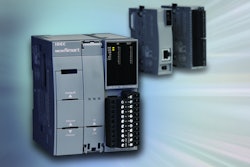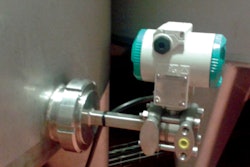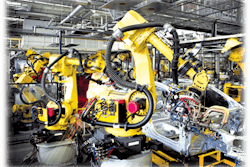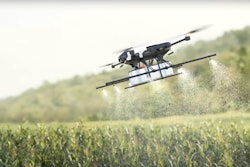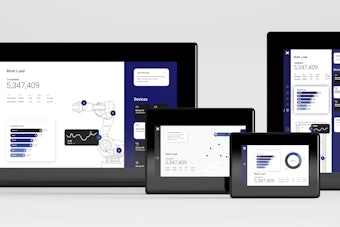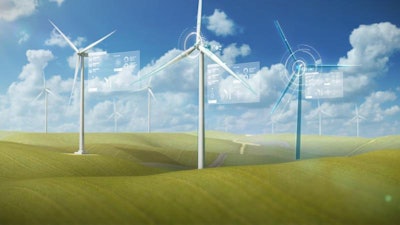
Renewable energy industries like wind and solar have seen their ups and downs over the years with market changes driven by a number of factors—government support and the current price of fossil fuels not least among them. Despite concerns about grid compatibility and energy storage, renewables seem to have come into their own, competing head-on with traditional sources.
Automation has a critical role to play in not only bringing down the cost of the initial production of solar panels and wind turbines, but also helping the established infrastructures get the most energy possible out of existing assets—increasing reliability and uptime, and optimizing the production and delivery of the energy those assets produce.
That conversation has changed a bit in recent years, Sylawa notes. “There’s a realization in industry that it’s not just a solar array or wind farm. It’s a power generating plant, and it’s got to run for 20 years,” he says. “It’s all about optimizing asset performance—even more so now because the industry recognizes it. We now have critical mass of wind and solar generation.”
Optimizing existing assets
The efficiency of existing assets is always the most critical element in renewables, agrees Rich Carpenter, general manager of control platforms at GE Power. “Renewable energy is, in theory, free. And there’s a fixed cost to get the infrastructure in place. So the efficiency to get the electricity matters,” he says. “Controls play a very significant role in getting efficiency out of the equipment.”
In the case of solar, that control could be relatively simple. If it’s sunny today and sunny tomorrow, but the output is less tomorrow than it was today, then you’ve got to understand what’s causing the discrepancy. “Maybe there was a bird on the solar panels and something got disconnected,” Carpenter says. “The faster you can figure out why you’re getting less output, the faster you can fix it.”
Wind energy is not as consistent, requiring more control to optimize efficiency. “On a wind farm, all elements are not getting the same wind in the same way,” Carpenter says, noting that the front windmills could affect the wind that the back windmills are getting, for example. “Controls are focused on getting the pitch and orientation of blades to catch the wind. At the farm level, how do the front units tell the rear units what’s happening so they know what to expect?”
GE’s digital wind farm creates a more connected, dynamic and adaptable wind energy system—optimizing both the production of the turbines and the operation of them after installation. In production, GE uses a digital twin modeling system to build up to 20 different turbine configurations at every unique pad location across a wind farm to generate power at peak efficiency based on the surrounding environment. The digital twin also analyzes turbine operations in real time and makes adjustments to boost operating efficiencies.
On the wind farm, connected sensors on the turbines gather data that is analyzed in real time with GE’s Predix software, which allows operators to monitor performance from data across turbines, farms or entire fleets. The data provides information on temperature, turbine misalignments or vibrations that can affect performance.
Though most people might think clouds are no friend to solar energy—particularly when they block the sun’s rays and keep a panel from producing electricity—Honeywell is a big proponent of the cloud for solar.
Getting visibility into existing assets is easier with cloud computing, for one, says Honeywell’s Bob Ell. And for a solar business just getting set up, taking advantage of cloud technologies can provide better techniques for building and configuring the system. “They have modern technology and infrastructure managed by Honeywell,” he says. “They don’t have to worry about upgrades or software, and can use standard telecommunications and cybersecurity techniques.”
A big challenge that control faces right now is the growing size of wind turbines. “The units are getting bigger and taller, the blades are longer, which puts a lot of stress on the blades, but they can produce a lot of power,” Carpenter says. That’s a model-based control problem requiring a lot of complex math. “The better you can react, the more you can optimize the power while reducing the risk of damaging the unit itself.”
What those increasingly complicated algorithms call for is more processing power at the edge, Carpenter says, using multicore processors for control. While standard control is done deterministically in one core, the models run in a non-deterministic controller on another. Acting as a digital twin, it can pass commands over to the deterministic side to optimize the way the turbine is run. “Large models need a lot of horsepower to run,” Carpenter adds. “We’re putting a lot more horsepower at the edge to run that.”
Improving asset uptime
Without even getting into optimizing performance, downtime alone is costing renewable energies dearly. In the United States, wind energy grew almost 20 percent in 2016—with more than 52,000 wind turbines producing 226 TWh of energy, according to the Energy Information Agency (EIA). But according to a recent report from Uptake, a predictive analytics startup, there is some 12 TWh of untapped energy caused by downtime in the current U.S. wind fleet. Even a 1 percent increase of availability would result in about 2.4 TWh additional energy annually, which is enough clean energy to power 222,000 homes for a year.
The cost savings for wind producers are significant as well. “Within a few days of deploying advanced analytics at a wind producer, they were able to save about $250,000 in damages and downtime by predicting main bearing failure,” says Ray Blitstein, vice president for renewables at Uptake. “It was during the winter, which is one of the most productive seasons of the year, so it had a significant impact on the side of availability and productivity.”
Another fleet operator in the Midwest had a turbine that was unavailable to produce energy, reportedly because there was no wind. And yet the turbine right next to it was producing energy. That problem is difficult to ascertain “until you have very simple tools with a complex back end,” Blitstein says. As they were able to learn with the right data, a miscalibrated anemometer kept the turbine from producing energy even when there was wind.
Part of the move to the edge is an increasing number of sensors everywhere on the assets. Ice detection, vibration sensing and bending moments are just a few of the measurements enabled by the proliferation of sensors in the industry.
Just as ice causes problems on an airplane’s wings, it can also create havoc with a wind turbine’s load. Turbine operators can get real-time data off the asset, and when there’s icing on the blades, they shut the turbine down, Sylawa explains. However, the operators don’t have a good way to know when the ice melts, so they often miss out on potential uptime. Sensors could give them the real-time data they need to determine when to start the turbine back up.
The item that gets the most wear and tear on a turbine is the gearbox, according to Sylawa. Using sensors to measure the blade’s bending moment helps to understand the load on the turbine and how it will affect the gearbox. “We can optimize the performance of the gearbox by loading it effectively and extend the life of the gearbox,” he says. “We get better performance and reduce the need for maintenance.”
Particularly as wind turbines get bigger and taller, the very height and exposure that make them good for catching the passing wind also make them highly susceptible to damage from lightning strikes. An important product in Phoenix Contact’s portfolio for wind energy is its Lightning Monitoring System (LM-S), which uses polarimetric sensing to measure and analyze a full range of lightning surge current characteristics precisely and accurately.
Lightning current measurement systems have previously been difficult to implement, or have provided a limited range of information, according to Phoenix Contact. Sending workers out to physically inspect turbines requires a lot of labor and cost, and it’s not always possible to distinguish between lightning strikes and other types of damage, Sylawa says. Polarimetric sensors, on the other hand—with their light weight and small size—enable easy installation on wind turbines, and can be installed in both new and retrofit applications.
The solar industry is seeing the same sorts of trends with sensors, according to Sylawa. Poor performance on a solar farm is often not caused by the cells themselves, but by any number of issues like connectivity problems, cloud cover or other issues with shading. An increasing number of connected sensors are enabling utilities to get real-time data from their solar arrays to maximize power production, minimize operations and maintenance costs, and maximize the array performance ratio.
Phoenix Contact technologies enable monitoring down to the string level, which can help identify hidden array losses and can also help locate failure points.
Factory automation
With such a focus on optimizing existing assets, it’s important that solar cell manufacturers not lose sight of the efficiency gains to be made by optimizing production on the factory floor as well. “Without major investments, the solar solutions of today will have difficulty competing with fossil fuel sources, especially with the current low prices,” says Dan Western, industry segment sales manager for electronics and assembly at Festo.
Festo has focused in particular on creating a complete system for motion needs, Western says. “In general, solar manufacturing needs to find ways to automate with flexible automation, such as electric automation, which can allow for some easy changeovers for product changes, keeping the overall cost lower by not purchasing new automation equipment for a new product line,” he says.
Keeping the power grid stable
Battery storage causes the biggest challenge with renewable energy entering the grid. When the wind is not blowing or the sun is not shining, the weakening energy load means the rest of the system has to reorient, Carpenter notes.
There are various ideas about how the industry might orchestrate the dance between energy types going forward, but what a lot of power companies use today to manage the load are peakers—power plants that run only when there is high demand (i.e., peak times).
“But you have to know when to spin it up,” Carpenter says, painting a picture of a relevant scenario. “You’re in the middle of the day, 4th of July, it’s super hot, and everybody is running their air conditioning. You’ve had good renewable energy coming into the grid, but all of a sudden it gets cloudy. Somebody would then take a gas turbine that wasn’t running and get it up and running.”
The grid of the future could have that control happening automatically, factoring in weather data energy demands, available sources and more.
Getting the data needed to understand the best times to operate assets is particularly important in California, where renewables are now making up a significant part of the state’s energy profile. “Wind turbines happen to be relatively popular in California, and have been around for three decades,” notes Benson Hougland, vice president of marketing and product strategy for Opto 22.
Although we tend to think about wind energy not being efficient if the wind isn’t blowing, putting too much wind energy onto the grid can create just as much problem. “The grid has issues with dispatchable load—the ability to turn loads on or off based on market conditions, weather, demand, all kind of reasons,” Hougland explains.
To force wind turbines to be dispatchable and keep energy levels in balance, electric company California ISO has begun manipulating the market price for the electricity that the turbine generates. “If they need to curb that load because there’s not enough demand, they will turn the market price way, way down,” Hougland says. “If they need to turn the load off, they turn it to a negative market price. So if you’re still spinning your turbine and putting energy on the grid, you’re writing them a check.”
Long-term success with wind means many of those turbines in California are decades old and lack the remote monitoring and control systems that would help them curtail or ramp up production as needed. The utilities were having to staff their wind farms around the clock with technicians to physically turn individual turbines on or off in as little as five minutes or else face financial penalties.
Instead, SCADA Solutions developed its WindCapture online monitoring and control system to remotely monitor and automatically manage wind farm power generation down to the individual turbine. The system uses Opto 22’s SNAP PAC controllers supervising individual I/O controllers on each turbine, a wireless mesh radio network for communications, and Opto 22’s groov operator interface for mobile devices.
“Opto 22’s software application suite gives us a variety of interfaces and protocols and the ability to push OPC data to the cloud, while groov allows our customers to access live turbine data and control those turbines from a smartphone or other mobile devices,” notes Craig VanWagner, engineer for SCADA Solutions.
The system is able to make an API call to California ISO to identify the locational marginal price (LMP) for that region and turn the turbine off if necessary. “Cal ISO gets what they want, and the owner/operators are not forced to write a check,” Hougland says.
To be sure, for traditional energy companies that have been used to working with more stable sources of energy, renewables create some new challenges along with the opportunities. But utilities have become more open to hearing about new technologies, according to Ell. “There are changing paradigms in renewables. It’s more like the Wild West,” he says. “They’re willing to listen and try things that they may not have in the past.”
